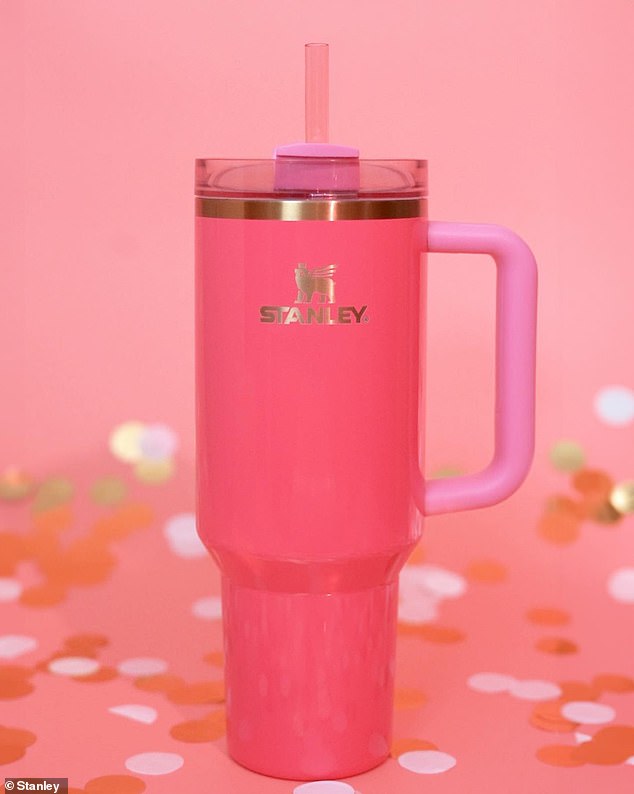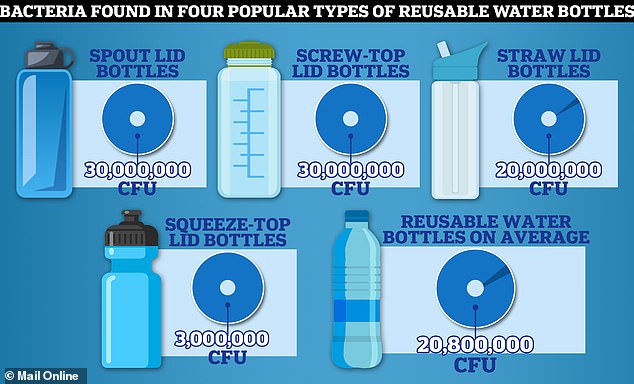Is your Stanley Cup REALLY harboring thousands more germs than your toilet bowl? Expert reveals the truth about the hygiene of your favorite water bottle
The Stanley water bottle became a worldwide phenomenon due to its range of colors and claims to be able to keep drinks cold for hours and even days at a time.
The brand's Super Quencher, which holds 40 oz of liquid and keeps drinks frozen for up to two days, has taken over social media over the past year.
Search “Stanley Cup” on TikTok and you will find over 50 million views on TikTok and 1.6 million posts on Instagram.
But TikToker Emily Zeck caused fear on the site in October when she showed off her dirty, unwashed Stanley lid – covered in brown mud.
“Did I drink out of this?” she asked, in the clip that has been viewed more than 12 million times.
The comments make for troubling reading for Stanley Cup users.

TikToker Emily Zeck sparked fear in a viral video showing off her dirty Stanley lid
One woman wrote, “I'm recovering from mold poisoning from my Stanley,” while another woman commented, “Maybe this is why my stomach hurts and my water tastes funny.”
There are also suggestions that a piece of plastic containing the straw 'provides easy access to mold', and that the gray stopper in the center of the cup contains 'even nastier stuff'.
Additionally, recent studies have suggested that frequent use of reusable plastic water bottles can lead to nasty infections due to the shocking amount of bacteria they contain.
Research published in March found that most reusable bottles contain around 40,000 times more bacteria than the average toilet seat.
Meanwhile, other experts have done the same warned of the risks of contracting E-coli – resulting in around 2,000 hospital admissions per year – from water bottles left lying around in gym bags or touched with dirty hands.
Could the thousands of devoted Stanley Cup fans be in danger?

Stanley's water bottles have skyrocketed in popularity over the past year, racking up 50 million views on TikTok
Dr. Daniel R. Kuritzkes, chief of the Division of Infectious Diseases at Brigham and Women's Hospital in Boston, told DailyMail.com that there is actually little to worry about.
“Water, especially if it comes from a safe source such as a tap in your home or a filtered water supply, contains very low levels of bacteria that can actually cause illness.”
“So there is little cause for concern.”
But what about the aforementioned study, which found 20.8 million live microbes in four different types of water bottles?
By comparison, the researchers found that a toilet seat has only 515.

Researchers from waterfilterguru.com swabbed four types of water bottles to see how many colony-forming units (CFUs) had formed. On average, they contain 20.8 million CFUs of gram-negative bacteria. For comparison: a toilet seat has 515.
Dr. Kuritzkes said the results of this study – by water treatment company waterfilterguru.com – have caused unnecessary panic.
Although researchers did not reveal what type of bacteria they found, it is not a form that is likely to cause serious illness like salmonella or E. coli.
'A plain water or carbonated water, even flavored water with no calories, will not pose a significant risk to humans as it will only encourage the growth of harmful bacteria.
'Just because bacteria is present doesn't mean it's a risk; many bacteria are harmless or can even be healthy.'
He added that there is 'theoretically' a minimal possible risk of pseudomonas bacteria – which in rare cases can lead to blood infections and pneumonia.
The beetle is found in soil and may come from some water sources.
However, it is unlikely to colonize and spread when ingested.
According to the Centers for Disease Control and Prevention (CDC), hospitalized patients who contract the infection from ventilators, catheters and other medical devices are at the highest risk for pseudomonas infection.
Surprisingly, Stanley's large size also does not make it more vulnerable to contamination.
Critics on social media have suggested that the bottles' 40-ounce capacity means standing water is more likely to build up, causing contamination.
But Dr. Kuritzes says, “It would have to take days and days and days for there to be a significant increase in bacteria,” Dr. Kuritzkes said.
'And there is a limited nutrient supply in the water. There is virtually nothing in it for the bacteria to grow on.'
“It doesn't matter how much water there is or how long it sits because it won't spoil.”
You also don't have to worry about contamination from Stanley's straw, even though it is always exposed to the environment, unlike bottles where the straw collapses.
Dr. Kuritzkes said: 'We do not find any disease-causing bacteria and viruses in the surrounding air. It is not the case that harmful E. coli or salmonella will somehow settle from the air onto the straw.'
The March survey also found that more than one in 10 Americans clean their water bottles only a few times a month.
However, unless you drag your Stanley through the mud or leave it outside most of the time, Dr. Kuritzkes said you probably don't need to worry about washing it often.
“I don't think it's really that important that it's washed with soap and water,” he said. “It's very unlikely that it will make you sick.”
In 2016, Charles Gerba, Ph.D., a microbiologist at the University of Arizona Self magazine that with the riskiest types of bottles you have to use your fingers to reach the straw.
These can harbor insects such as E-coli.
He said, “Those are the only ones you see problems with because people's fingers are contaminated.”
